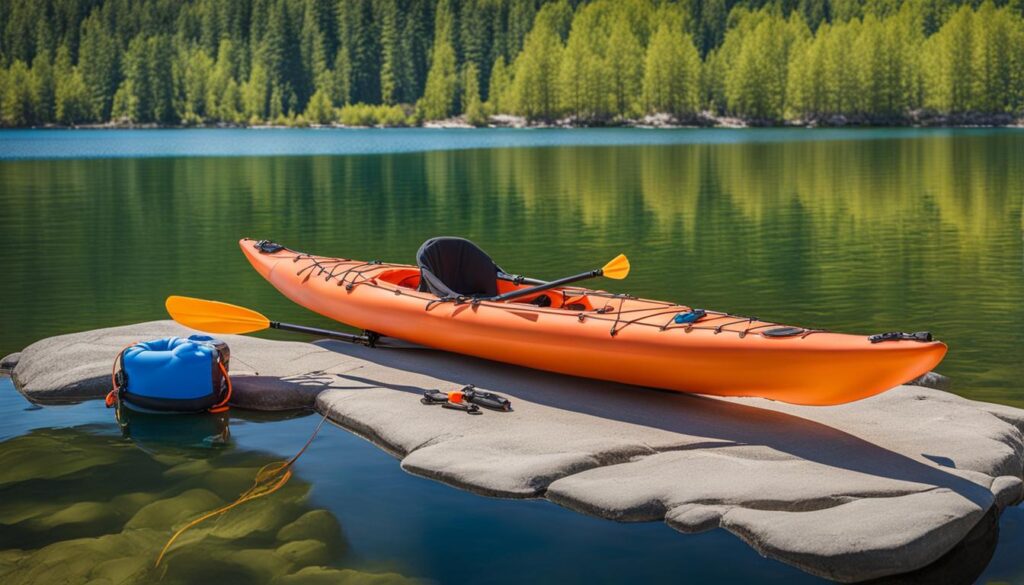Are you ready to hit the water and embark on an exciting kayaking adventure? One of the essential steps in preparing for your kayaking trip is properly inflating your inflatable kayak. Inflating an inflatable kayak might seem daunting at first, but with the right techniques and tools, it can be a breeze. This guide will walk you through the step-by-step process of inflating your kayak, ensuring you have a safe and enjoyable experience on the water.
Key Takeaways:
- Properly inflating an inflatable kayak is crucial for its longevity and performance.
- Partially inflate the main air chambers (floor and side walls) before fully inflating.
- Select a dry, flat area to inflate your kayak and check for any leaks or issues.
- Adjust the air pressure according to the temperature to ensure optimal performance.
- Carry a repair kit and safety kit on board for any unforeseen situations.
Required Equipment & Tools For Inflating And Deflating A Kayak
When it comes to inflating and deflating your kayak, having the right equipment is essential for a smooth and successful experience. Here are the necessary tools and equipment you will need:
A High-Pressure Air Pump
To efficiently inflate your kayak, a high-pressure air pump is a must-have. Look for a pump that is specifically designed for inflating inflatable kayaks. This will ensure that you can inflate your kayak to the recommended PSI quickly and easily.
A Pressure Gauge
A pressure gauge is necessary to ensure that you are inflating your kayak to the correct air pressure. This will help maintain the durability and performance of your kayak. Make sure to check the manufacturer’s guidelines for the recommended PSI for your specific kayak model.
Valve Adapters
Valve adapters are essential for connecting your air pump to the valves on your kayak. Different kayaks may have different types of valves, so having a set of valve adapters will ensure that you can easily inflate and deflate your kayak regardless of the valve type.
A Repair Kit
A repair kit is a crucial tool to have on hand in case of any unexpected leaks or damages. Make sure your repair kit includes patches, adhesive, and a valve wrench. This will allow you to quickly fix any issues that may arise during your kayaking adventures.
A Tarp
A tarp is useful for protecting your kayak during the inflation and deflation process. It provides a clean and dry surface for the kayak and helps prevent any damage or punctures. Place the tarp underneath your kayak when inflating and deflating to ensure a smooth and safe experience.
By having these essential tools and equipment, you will be well-prepared to inflate and deflate your kayak with ease and confidence. Remember to always follow the manufacturer’s guidelines and take proper care of your kayak to ensure it lasts for many enjoyable adventures on the water.
Table: Required Equipment and Tools for Inflating and Deflating a Kayak
| Equipment | Description |
|---|---|
| High-Pressure Air Pump | A pump designed specifically for inflating inflatable kayaks, ensuring quick and efficient inflation. |
| Pressure Gauge | A gauge to measure and maintain the correct air pressure in your kayak according to the manufacturer’s recommendations. |
| Valve Adapters | Adapters to connect your air pump to the valves on your kayak, accommodating different valve types. |
| Repair Kit | A kit containing patches, adhesive, and a valve wrench for quick repairs in case of leaks or damages. |
| Tarp | A protective tarp to place underneath your kayak during inflation and deflation, preventing damage and punctures. |
How To Inflate A Kayak – A Step By Step Guide
When it comes to inflating a kayak, following a step-by-step guide can ensure a smooth and hassle-free process. By following these instructions, you’ll be able to enjoy your kayaking adventure without any inflation-related issues.
Unfold and Lay Out the Kayak
The first step is to find a suitable area to unfold and lay out your kayak. Ensure that the surface is dry and free from any debris that may puncture the kayak. Once you have found a suitable spot, unfold the kayak and lay it flat with the top side facing up.
Inflate the Floor Chamber
Next, locate the floor chamber valve and attach your pump. Begin inflating the floor chamber, making sure to use smooth and even strokes. Keep an eye on the pressure gauge to ensure proper inflation. Once the floor chamber is partially inflated, move on to inflating the wall chambers.
Inflate the Wall Chambers
Each kayak will have multiple wall chambers that need to be inflated. Locate the valves for the wall chambers and attach your pump accordingly. Inflate each chamber evenly, taking care not to overinflate or underinflate. It is important to ensure that all chambers are partially inflated before moving on to fully inflating the kayak.
Fully Inflate the Kayak
Once the floor and wall chambers are partially inflated, it’s time to fully inflate the kayak. Attach your pump to the main valve and begin inflating the kayak until it reaches the required air pressure. This may vary depending on the specific kayak model, so refer to the manufacturer’s instructions for the correct pressure.
Inflate Seats and Other Accessories
After fully inflating the kayak, it’s time to inflate the seats and any other accessories that came with your kayak. Attach the pump to the valve of each seat or accessory and inflate them to the desired firmness. This will ensure a comfortable and enjoyable kayaking experience.
Insert the Skeg
If your kayak has a removable skeg, this is the time to insert it. The skeg helps with tracking and stability in the water. Make sure it is inserted securely according to the manufacturer’s instructions.
Inspect the Inflatable Kayak
Before launching your kayak, it’s important to thoroughly inspect it for any signs of leaks or issues. Check each chamber and valve for air leakage, and ensure that all valves are properly closed. This will help prevent any unexpected deflation while you are out on the water.
Table: Required Steps for Inflating a Kayak
| Step | Description |
|---|---|
| 1 | Unfold and lay out the kayak in a dry and debris-free area. |
| 2 | Partially inflate the floor chamber using smooth and even strokes. |
| 3 | Inflate each wall chamber evenly, ensuring they are partially inflated. |
| 4 | Fully inflate the kayak to the required air pressure. |
| 5 | Inflate seats and other accessories to the desired firmness for comfort. |
| 6 | Insert the skeg securely for improved tracking and stability. |
| 7 | Thoroughly inspect the kayak for any signs of leaks or issues before launching. |
How To Deflate A Kayak – A Step By Step Guide
Deflating a kayak is a straightforward process that can be easily accomplished by following a few simple steps. By properly deflating your kayak, you can ensure its longevity and maintain its performance for future adventures. Here is a step-by-step guide to deflating your kayak:
Step 1: Find a Suitable Location
Choose a flat and clean area where you can comfortably deflate your kayak. It’s important to find a location free from sharp objects or debris that could potentially damage your kayak during the deflation process.
Step 2: Remove Seats and Accessories
Prior to deflating your kayak, remove any seats, accessories, or attachments that are not permanently fixed to the kayak. This will make the deflation process easier and help avoid damage to these items.
Step 3: Towel-Dry the Kayak
Before deflating, it’s a good idea to towel-dry the interior and hull of the kayak to remove any excess moisture. This will help prevent the growth of mold or mildew and keep your kayak in optimal condition.
Step 4: Open the Valves and Let the Air Out
Locate the valves on your kayak and open them to release the air. It’s important to fully open the valves to allow the air to escape easily. You may need to press down on the kayak to help expel the air more quickly.
Step 5: Fold, Roll, and Dry the Kayak
Once the kayak is deflated, fold the sides towards the center and then roll it tightly from the bow to the stern. This will help minimize the size of the kayak for storage or transportation. Afterward, ensure the kayak is completely dry to prevent any moisture-related damage.
Step 6: Pack the Kayak for Storage or Transportation
Once your kayak is folded and rolled, you can pack it into a suitable storage bag or container. Make sure the kayak is protected from any potential damage or external elements that could affect its condition. Store it in a cool and dry place until your next adventure.
By following these simple steps, you can safely and effectively deflate your kayak, ensuring it remains in good condition and ready for your next paddling excursion.
Troubleshooting Tips & Tricks
If you encounter any issues during the inflation of your inflatable kayak, don’t worry. Troubleshooting common problems can help ensure a smooth and successful inflation process. Here are some tips and tricks to help you troubleshoot and resolve any difficulties you may face:
Slow Air Leak
If you notice a slow air leak in your kayak, first check if the valves are properly closed. Sometimes, the valves may not be fully sealed, causing air to escape. Ensure that the valves are tightly closed and secure. If the leak persists, carefully inspect the kayak for any punctures or damages. Apply some soapy water to the suspect area and look for bubbles. If you find a puncture, use your repair kit to patch it up.
Leaky Valves
Leaky valves can also be a common issue. If you notice air escaping from the valves even when they are closed, check if the valve caps are securely tightened. Sometimes, loose caps can cause air leakage. If the problem persists, there may be a faulty valve. In this case, it’s best to contact the manufacturer for assistance or consider replacing the valve.
Difficulty Inflating
If you’re having difficulty inflating your kayak, make sure that you are using the correct pump and attachments for your kayak’s valves. Some kayaks may require specific valve adapters to ensure a proper seal. Additionally, check if there are any blockages or debris in the valves that may be hindering the airflow. Clearing any obstructions and ensuring a secure connection between the pump and valves can help resolve this issue.
Poor Tracking or Stability
If you experience poor tracking or stability while kayaking, it may be due to underinflation or uneven inflation of the main air chambers. Ensure that all the chambers are properly inflated, paying attention to the floor and side walls. Use a pressure gauge to measure the air pressure and adjust accordingly. Properly inflating the kayak will help improve its tracking and stability on the water.
Remember, troubleshooting inflatable kayak inflation requires patience and attention to detail. By following these tips and tricks, you’ll be able to overcome common issues and enjoy a smooth kayaking experience. Now that you’re equipped with troubleshooting knowledge, you’re ready to hit the water with confidence!
Frequently Asked Questions on Inflating and Deflating Inflatable Kayaks
Here are some answers to frequently asked questions about inflating and deflating inflatable kayaks:
FAQ 1: How long does it take to inflate a kayak?
The inflation time for a kayak can vary depending on the size and type of pump used. Manual inflation with a high-pressure hand pump typically takes around 5-10 minutes, while using an electric pump can significantly reduce the time to just a couple of minutes.
FAQ 2: Can I use an electric pump or an air compressor to inflate my kayak?
Yes, you can use an electric pump or an air compressor to inflate your kayak. These tools can make the inflation process faster and more convenient. However, it is important to monitor the air pressure closely to avoid overinflation, which can damage the kayak.
FAQ 3: Is it safe to leave the kayak inflated?
Leaving the kayak inflated for a short duration, such as during a lunch break or while enjoying a short break on the water, is generally safe. However, it is not recommended to leave the kayak fully inflated for extended periods, especially in hot or sunny conditions, as excessive heat can cause the air pressure to increase and potentially damage the kayak.
FAQ 4: What is the required PSI for inflatable kayaks?
The recommended PSI (pounds per square inch) for inflatable kayaks can vary depending on the manufacturer and model. It is essential to refer to the specific instructions provided by the kayak manufacturer to determine the correct PSI for inflating your kayak. Overinflation or underinflation can affect the performance and durability of the kayak.
| FAQ | Answer |
|---|---|
| How long does it take to inflate a kayak? | The inflation time for a kayak can vary depending on the size and type of pump used. Manual inflation with a high-pressure hand pump typically takes around 5-10 minutes, while using an electric pump can significantly reduce the time to just a couple of minutes. |
| Can I use an electric pump or an air compressor to inflate my kayak? | Yes, you can use an electric pump or an air compressor to inflate your kayak. These tools can make the inflation process faster and more convenient. However, it is important to monitor the air pressure closely to avoid overinflation, which can damage the kayak. |
| Is it safe to leave the kayak inflated? | Leaving the kayak inflated for a short duration, such as during a lunch break or while enjoying a short break on the water, is generally safe. However, it is not recommended to leave the kayak fully inflated for extended periods, especially in hot or sunny conditions, as excessive heat can cause the air pressure to increase and potentially damage the kayak. |
| What is the required PSI for inflatable kayaks? | The recommended PSI (pounds per square inch) for inflatable kayaks can vary depending on the manufacturer and model. It is essential to refer to the specific instructions provided by the kayak manufacturer to determine the correct PSI for inflating your kayak. Overinflation or underinflation can affect the performance and durability of the kayak. |
Conclusion
Inflating an inflatable kayak is a straightforward process that can be easily mastered with practice. By following the step-by-step guide provided in this article, you can ensure that your kayak is properly inflated, leading to a safe and enjoyable kayaking experience.
It is important to remember to partially inflate the three main air chambers before fully inflating them, and to check for any leaks or issues before launching your kayak. Adjusting the air pressure according to the temperature and carrying a repair kit and safety kit on board are also crucial steps to ensure a smooth inflation process.
With the right equipment, such as a high-pressure air pump, pressure gauge, valve adapters, repair kit, and tarp, inflating and deflating your kayak becomes even easier. By troubleshooting any common issues and understanding the frequently asked questions, you can overcome any challenges that may arise during the inflation process.
So, get ready to hit the water and enjoy the thrill of kayaking with your properly inflated inflatable kayak. Remember, a well-inflated kayak ensures stability, maneuverability, and an overall better kayaking experience. Happy paddling!
FAQ
How long does it take to inflate a kayak?
With practice, inflating a kayak should take no more than 10 minutes.
Can I use an electric pump or air compressor to inflate my kayak?
Yes, electric pumps and air compressors can be used to inflate a kayak as long as they are compatible with the kayak’s valves.
Is it okay to leave the kayak inflated?
It is generally recommended to deflate and store the kayak after each use to prevent damage and prolong its lifespan.
What is the required PSI for inflatable kayaks?
The required PSI (pounds per square inch) for inflatable kayaks can vary depending on the manufacturer and model. It is important to consult the kayak’s user manual for the recommended PSI.







